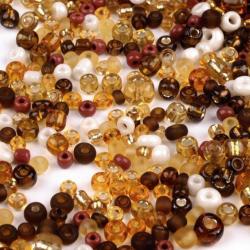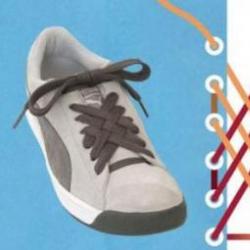A tie for a girl to go with her school uniform. How to sew a men's tie Pattern of a tie with an elastic band for a man
Ties are gaining more and more popularity as a fashion accessory that can be worn not only with an office suit. And given the growing interest in making things with your own hands, it is not surprising that many people are making their own unique ties. A tie can be made from almost any fabric, choosing any color, pattern and length, and the price will be significantly lower than that of a purchased tie. Regardless of whether you are sewing a tie for yourself or preparing an original gift for your father for the New Year or Defender of the Fatherland Day, use our simple instructions.
Steps
Selection of necessary materials
- A popular lining fabric option for ties is rayon.
- The main fabric for an informal tie can be cotton, linen or denim with a pattern.
-
Purchase some interlining material for the inside of the tie. Ties are made using interfacing materials that can be sewn or iron-on to the wrong side of the main fabric of the tie. They allow the tie to keep its shape. You will need 1.35m of interlining material that matches the tone of the main fabric.
Purchase other necessary materials. In addition to fabric and padding, you will need to purchase the following:
- thin threads in the color of the main fabric of the tie;
- good fabric scissors;
- a sewing machine or sewing needle (if you sew by hand);
- sewing pins;
- measuring tape;
- iron.
-
Choose a suitable pattern. There are many possible tie patterns. When you decide on the product model you like, you can easily print the corresponding pattern for free directly from the Internet. An alternative to printing out a pattern is to trace the outline of an existing tie using a pencil and ruler.
Purchase your favorite fabric from your local fabric store. To make a great tie, there is no need to stick to any specific type of fabric, however, keep in mind that thicker fabrics are better suited for this purpose. To make one tie, you will need at least 1.35m of fabric for the main part and a piece of lining fabric measuring about 13x15cm for the back.
Preparing fabric for sewing a classic tie
- If the fabric has a pattern, try to imagine how it will fit on the cut tie. Adjust the position of the pattern so that the fabric pattern looks good on the finished product.
-
Transfer the outline of the tie pattern onto the fabric. Pin the pattern to the fabric with sewing pins or simply press it onto the fabric. Then use chalk to carefully trace the outline of the pattern onto the wrong side of the fabric. In sewing, chalk is usually the easiest and safest tool for transferring the outlines of patterns onto fabric.
Carefully cut the fabric. Take sharp fabric scissors and cut the fabric 1cm away from the chalk outline. This way you will create seam allowances. If you have chosen a difficult-to-cut fabric for your tie, you may need a roller cutter instead of scissors to cut it.
- Cut out without haste so as not to make mistakes and spoil the fabric.
-
Repeat the cutting process with the interlining material. Place the tie pattern on the interfacing material and use chalk to trace its outline. Then carefully cut out the piece using scissors or a fabric cutter. The interfacing piece will have the same shape as the main fabric piece, however it will not need seam allowances so you should cut it straight along the chalk line.
Cut out the piece from the lining fabric. You will need to measure and cut a piece of lining fabric along the contours of the bottom tip of your tie. It will cover the back side of the tip of the tie, which will remain sticking out after folding and sewing the tie itself. The same part can additionally be used as a pocket to secure the narrow end of a tied tie. This detail has an upper horizontal side, and on the bottom and sides it follows the contours of the lower tip of the tie.
Securing the cushioning material
-
Check the gasket material. Before attaching the interlining material to the main fabric of the tie, once again make sure that it has been pre-planted at the factory or by you personally. Also, depending on whether the material is adhesive or sewn, follow the appropriate instructions for working with this material.
Iron on the adhesive interlining material. If you purchased adhesive interlining, this step is where you should iron it to the fabric. To do this, you must place the shiny or bumpy side of the interfacing material on the wrong side of the main tie piece. The easiest way to do this is to place the main part of the tie face down on the table. Then you need to put the shiny side on top of it, made from cushioning material. To protect parts from shifting and sticking to the iron when ironing, cover them with a thin towel before ironing rather than ironing them directly.
- Make sure that the adhesive interlining material is evenly adhered to the entire surface of the tie.
-
Sew on the sewing interfacing. If you purchased interfacing that does not have an adhesive layer and is designed to be sewn on, you will need to sew it to the base fabric. This type of interlining material is well suited for sewing ties on fabrics that are sensitive to heat treatment. You can sew the cushioning material by hand using a needle and thread or using a sewing machine. Sew interlining material to the wrong side of the main tie piece all the way around.
-
Start with a classic tie pattern. This model is quite simple and versatile. You can find various patterns of the classic tie model, which will differ in their length and width. Just print out the one you like best, but just make sure that it is the classic tie model with a corner at the bottom.
Please be aware that the fabric may shrink. If you chose something other than natural silk as the main fabric of your tie, you should pre-shrink the fabric by washing and drying it before ironing. This will allow you to avoid worrying about the fabric shrinking after steaming or washing the finished tie.
Prepare the fabric. Before cutting, iron the fabric (at a low temperature) from the wrong side to remove any wrinkles or creases that could cause the fabric to cut unevenly. To iron, lay the fabric on the work surface, wrong side up, and begin moving the iron over it in small circular motions.
Cutting fabric
Position the tie pattern correctly on the fabric. It is very important to cut the tie on the bias (diagonally to the direction of the grain thread), as this will make the tie more elastic. Be sure to make sure that the fabric lies flat and without any wrinkles before cutting.
Sewing a classic men's tie with a loop should be entrusted to experienced tailors, but sewing a tie with an elastic band is not as difficult as it seems. And it is very easy to use. An elastic tie can be in the shape of a butterfly, or it can be something like a classic men's accessory; it is also called a “herring”. An elastic tie can decorate both a child's outfit and an adult's outfit.
Preparing materials for sewing a tie
To sew a tie, we need:
- - a small piece of non-elastic material: suit, cotton or silk fabric will do, depending on the image you have in mind;
- - a piece of adhesive interlining to seal the main fabric of the accessory;
- - sharp scissors that will allow you to make high-quality cuts;
- - threads to match the fabric;
- - hat elastic or elastic for straps;
- - ruler;
- - a special marker or chalk for marking.
If you want to sew a classic tie, then you will need a piece of lining fabric. If the fabric you choose is quite dense, then the adhesive sealant may not be used.
Now you need to create a pattern, this can be done directly on the fabric. It is better to pre-print a pattern for a classic-shaped tie on paper.
Sewing a butterfly with an elastic band

To sew an adult bow tie, you should take a strip of fabric measuring 24 by 13 cm. By the way, to sew a bow, you can take a scrap of a similar size. Another strip, measuring 4 by 7 cm, needs to be cut to sew the connecting ring of the accessory. Cut a piece of the same shape from non-woven fabric and iron it to secure it.
Pin the workpiece together and apply a stitch at a distance of 0.5 cm from the edge along the long side.
Fold the workpiece so that the seam is in the middle, go over the seam with an iron.
Fold the piece in half so that the long seam is on the outside. Place a straight stitch along the short side, thereby sewing the element into a ring.
Turn the workpiece inside out and iron the seam.
The jumper should be sewn in the same way, but on the right side of the fabric, without turning it inside out. You should have both seams inside the ring. Turn the workpiece inside out.
We thread the main part into the ring and add folds. To fix them, you can lightly walk over them with a stream of steam. Although, thanks to the non-woven fabric, they will keep their shape.
We measure the neck and cut off the required length of the elastic to complete the accessory. We pass the elastic through the ring and grind it off. We hide the seam in the jumper.
We sew a strict men's tie

Elastic ties can be useful for both a themed party and a children's party. Don't forget that in addition to the main materials, you will need a piece of lining fabric so that the tie does not cling to the shirt or blouse and lies nicely.
So, the pattern. The easiest way is to find a ready-made pattern on the websites of needlewomen and print it out. This way you will save time and avoid mistakes in creating the accessory. Do not forget that you should make a small indent from the edge of the pattern for the seam, about 0.5 - 0.7 cm.
- Cut out the parts from the main and duplicating fabric, iron.
- For the bottom part of the herring tie, divide the pattern crosswise into 2 halves. The lower part is made of lining material. Connect the part into a single whole.
- Pin the workpiece with the right side inward, apply a straight stitch a little further from the edge. Turn it inside out and iron it.
- To form a knot in a tie, make a simple pattern:
- - a strip of base material should be equal to the length of the top of the product, multiplied by two. Don't forget to leave just under 1cm for seam allowance. The width of the knot depends on the size of the tie, on average 7-10 cm. Be sure to seal the element with non-woven material;
- - fold the part facing inward;
- - sew the element along the long side and turn it inside out;
- - fold in half so that the seam is in the middle;
- - slightly sharpen the corners of the rectangle to form a trapezoid,
- - fix the workpiece on top of the product, attach the elastic band and turn the finished tie through the ring, you will get a knot on top.
A stylish kanzashi tie for a girl will complement the school uniform and make the young fashionista stand out among her classmates.
Make your own elegant set in dark blue tones from a tie and two hair clips. Also suitable for school accessories are black, white, black and white, cream, gray fittings - everything should be expressive, but not bright. Carefully study the master class and strictly follow the step-by-step instructions and photos. If something doesn't work out the first time, repeat the steps.
Preparing materials for the school kit
To make kanzashi ties for school with your own hands, it is better to use grosgrain ribbons, although they are more expensive than satin ones. This is due to the high density of the material, suitable for the production of the described products. Rep creates a dense base, and lace adorns the set of accessories.
Modeling materials one bow:
- six pieces of dark blue thick grosgrain ribbon and “track” lace in a rich ink shade – 4*10 cm;
- black satin stripe for enhancing the middle – 1.2*12 cm;
- 16 pieces of dense ink grosgrain ribbon in a rich shade – 0.5*7 cm;
- a piece of lace “track” (in this case you will only need half, cut lengthwise) - about 16 cm;
- two dark felt circles of blue or black color as a basis for fastening and for a clamp with a diameter of 2.5 cm;
- traditional metal clip 7.5 cm long;
- the center is a flower or other decorative option selected in the store.
To do tie kanzashi for school uniform with your own hands, prepare materials taking into account the different components.
Top part tie (choose a thicker material to keep the shape well):
- four pieces of dark blue grosgrain ribbon and a thick ink-colored “track” lace – 4*13 cm;
- three pieces of ink grosgrain ribbon – 2.5*24 cm;
- two strips of dark blue rep ribbon and a lace “track” of rich ink tone – 4*20 cm;
- a piece of rep ink ribbon – 2.5*14 cm;
- lace “track” (cut in half lengthwise and use only half) – about 16 cm;
- the middle in unison with the blanks for bows.
Additionally, prepare for a tie in a dark blue striped grosgrain – 4*26 cm, a lace “track” in an ink shade – 4*26 cm. These parts need to be glued at the very end.
Bottom part Kanzashi tie for girls:
- two pieces of thick dark blue grosgrain ribbon and a lace ink “track” – 4*13 cm;
- ink rep ribbon – 2.5*10 cm;
- pin – 3 cm;
- dark felt rectangle.
How to make school hair bows
To make two bows with flowers for a school uniform in the same style as a kanzashi tie, take a double portion of materials according to the list. This refers to dark rep and lace ribbons, felt circles and centers.

Combine the pieces of rep and lace - six strips of 4 * 10 cm. Close the edges, leaving the lace on top.

Make a double gather where the ends meet and scorch to seal.

Prepare six identical loop pieces and a long thin ribbon for the middle.

Glue a bow from all the loops, dividing each in half. Wrap the middle with black material.

For a simple but beautiful flower, prepare half of a lace track 16 cm long, thin rep stripes - 16 pieces of 0.5 * 7 cm each, a black felt circle and a flower in the middle.

Make thin grosgrain loops. Glue all 16 loops evenly onto the felt circle. The lace can be immediately gathered into a circle using a needle and thread.

Glue the top flower.

Two parts of the bow are created.

Glue the hairpin together. Glue the clip to the back, pressing down with felt.

Duplicate all the steps to get a stylish pair.

You can also make simpler rep prints for the set using the selected color scheme.
MK on assembling a tie from grosgrain ribbons
To make a kanzashi tie for a girl with your own hands, prepare the accessories indicated in the list, consisting of various grosgrain and lace ribbons and a center.

Model four combined pieces of rep and lace measuring 4*13 cm. Make loops.

Gather the details into a bow.

Bend three thick ink pieces measuring 2.5*24 cm on both sides, joining the opposite ends in the center. Collect the resulting blanks together.

Also combine pairs of dark blue cut and lace parts measuring 4*20 cm. Gather into a bow.

And another fragment of a school kanzashi tie will consist of a folded dark strip measuring 2.5 * 14 cm, gathered into a circle of lace 16 cm long (halves) and a center.

17. Glue the X-shaped bow from the first portion of parts and the triple structure prepared in the second stage.

18. Glue the third and fourth model - crossed combined parts and a lace flower with a center.

19. Now fasten the two fluffy pieces together.

20. Prepare materials for the bottom of the tie: two pieces of dark grosgrain and lace ribbon measuring 4*13cm, a strip of grosgrain measuring 2.5*10cm.

21. Having aligned the large parts, cut them diagonally on one side symmetrically, sharpening a thin strip.

22. Glue two strips and a thin tongue.

23. Glue the tail from the bottom to the bow.

24. And the remaining details that will hide the back of the structure: one piece of dark rep, measuring 4*26 cm, and lace. Gather a double strip with loops at the ends.

25. Glue at the bottom. Attach a pin to the felt rectangle.

With a little effort, you will definitely end up with a beautiful set of hairpins and a kanzashi tie. A stylish set can be given to a friend or sister for a small holiday or without any reason. Take a look at our section with assembly lessons to always be stylish and fashionable!
A master class on making a tie from grosgrain ribbons and kanzashi-style hairpins with your own hands was prepared by Svetlana Sorokina. Especially for the online magazine “Women’s Hobbies”.
Satin ribbons are an excellent material for crafts and decorations. They are used to create amazing bows, hairpins and even ties that will decorate a schoolgirl’s blouse on September 1st. Such trendy accessories for schoolgirls can be created with your own hands from satin braid in just a couple of hours and your schoolgirl will be inimitable at the holiday line-up. A school tie is a fashionable accessory that will emphasize grace and add novelty to your school look.
To create a school kit you will need:
- Brown satin ribbon, 4 cm wide.
- White satin border, its width is about 2 cm.
- White braid with flowers as decorative trim.
- White organza 1 cm wide.
- Hot-melt gun and transparent glue stick.
- Tie clip.
- Pins or elastic bands as a basis for bows.
- Decorating elements in the middle of the products.
- Lighter.

At the first stage we will create a tie. It consists of several lush rows and a separate bow that decorates the top of the product.
For the tie you will need seven cuts, they are 13 cm long, four blanks are cut out of brown smooth ribbon.

Four such elements are bent with the wrong side inward, while the very edges of the part are stuck together with hot glue. The four blanks have identical bends.
A white border with flowers is added to the three remaining blanks; it should be located in the center of the main ribbon. To join both braids, you need to singe their edges together and squeeze them with tweezers or gloved fingers, remember that the melted synthetic material is very hot and can cause burns.

The tapes are seared on both sides, and in the center they are fastened with glue, which is applied with a needle or toothpick.
The edges of the double braid are also glued together with the right side outward to create curves on the other side of the part, like the brown blanks.

The first element with a border is glued to the bottom of the base of the tie, which will be a piece of brown ribbon, the length of which is no more than 15 cm.

Two plain blanks are glued on top of the lower element, approximately at right angles to each other, but at the same time they are attached at an angle to the first element.

The next tier of brown folds is created according to a similar scenario.

Now let's start forming the bow. For it, take three cuts of 11 cm each.

One of the cuts will be the horizontal base of the bow; to do this, glue the cut into a ring, fixing the edges of the material with two drops.

Apply the next drop of glue to the inner surface of the ring in the joint area and immediately press it to the opposite side to form a shape identical to the number eight.

The lace is attached to the remaining two cuts. You need to fix the white border using a lighter along the edges and glue in the center of the part.

The resulting element is glued to a horizontal base.

From a narrower ribbon (approximately 2 cm) another small bow is glued together, which will decorate the middle of the product, positioned horizontally.

Fix the part to the top of the base, and then decorate the middle with a metal element in a classic style.

The resulting bow is glued to the top of the base of the tie, that is, it must be positioned evenly above the wavy part of the voluminous product.

The tie fastener is glued to the non-face side at the top. This can be a special base like a brooch or a simple pin that fits the size. It is important to position the mount exactly horizontally so that the product itself does not move to one side when worn and looks not only festive and elegant, but also neat.

The second stage in this master class is devoted to a description of the creation of bows, which are perfect for school uniforms for the holiday of September 1st. They are created in accordance with the style of the tie, their main “highlight” is the combination of a brown satin ribbon with a white delicate border with the image of roses. Such bows will decorate schoolgirls' ponytails, braids, or pin up loose hair.
First, prepare the base of the bow from pieces of brown ribbon. Each product will require a 23 cm piece.

Roll it into an even ring, while only the very edge of the product is glued.


By gluing two opposite sides, turn the ring into a typical bow. This element will be the basis of the product; it will be located strictly across.
From a white ribbon, approximately 22 mm wide, two similar “eights” are created using the same type as the brown base.

Crosswise, two white elements are glued together into a cute bow.

To add volume and unusualness to the product, wavy elements are needed that will rise above the entire composition. To do this, you will need pieces of white organza 25 cm long.
The edges need to be twisted into a ring and glued to the middle of the braid, you get this unusual element.

The two parts are glued together in the center and form a piece of four flounces.

A white bow is glued into the center of the unusual blank, each edge is pushed into the rounded part of the transparent part and a voluminous bow is obtained.

Glue a white bow to the brown horizontal base.

To make the bows look like a set with a similar brown tie, you will need to attach a white ribbon with roses to the brown braid. To do this, take 15 cm long pieces of lace and satin ribbon and fasten their edges over the fire (the wrong side of the lace is placed over the smooth part of the satin). In the center, secure one border over the other with glue.

This element is glued into a simple bow similar to the brown bottom piece. Glue a new two-layer bow across the entire work, placing it strictly in the center. The middle of school bows is decorated with white flowers.

To attach the September 1st bows to the tails, you will need clips or elastic bands. The pins are glued to the back of the product. After fastening the material with a clip or elastic band, you need to press down the component parts and wait a few minutes until the glue dries. The bows are already ready!

A DIY tie and bows are unique, so your student will look the most beautiful on the first day of school.

I think this will be interesting for fans of exclusives, because... a creative tie will always help you stand out from the crowd.
Let's start with the cut. There are several options for constructing tie patterns. You can rip an existing tie (at the same time you can view the technology). Another option is to take advantage of the experience of others (those who have already figured out everything they need and shared their knowledge on the Internet))) Thanks to the pioneers!!!
Option 1 tie pattern:
Narrow end
Wide end

Processing corners. Method 2.
1.2 First, you need to draw lines on the basis of the tie (the boundaries of the corners in finished form).

2.2 We also apply the same lines on the lining (repeate them from the base one by one).

3.2 Iron the corners on the base along the marked lines.
IMPORTANT: The angle must be clearly marked! The final appearance of the corner will depend on this clarity.

4.2 Place the corner of the lining with the right side on the front side of the base. We clearly align the intended angles. Let's prick.

5.2 We sew a line from the corner to the edge of the cut. We take out the pins. You can iron it.

6.2 Once again we control the angle. Let's schedule it. Need clarity!


7.2 We grind the second side in the same way as the first.


8.2 Turn the corner inside out and iron it. Next from first method do points 6 and 7.
We sew the sides of the corner as seen in the picture:

Now we turn the entire structure right side out and iron it.

It turns out a very beautiful and neat look at the ends.

7. Now we put the canvas base into the tie, straightening the corners.
The canvas should be held tightly in the corners!
Pierce it in the center with pins.

8. We sew, thereby fastening both parts, and remove the pins.

9. We secure the edges of the allowances to the base with pins, and pin the middle with an overlay seam. Then we secretly hem it so that the hem is not visible.

10. Now we need to sew a loop that will keep the short end inside from inadvertently peeking out from under the top.
To do this, at a distance of approximately (it’s better to visually try it on and look at the “body”, it depends on how long the tie should be), 30 cm from the bottom of the wide side, mark the location of the loop.
We sew the loop manually, not through it, but only by grabbing the top layer of fabric and maybe even the canvas.

We pin the other side with a pin so that the loop is not sewn tightly, but so that there is a gap for the narrow end of the tie (we also sew it by hand).

11. Now we fasten the edges together at the narrow end of the tie.

And at the wide end we make the same fastening.

12. We also make a one-stitch tack above the loop. Approximately 1-1.5 cm higher.
This is necessary so that the tie does not break when the inner end of the tie is constantly being put in and then pulled out.

They worked and worked and here it is - a tie with your own hands!






